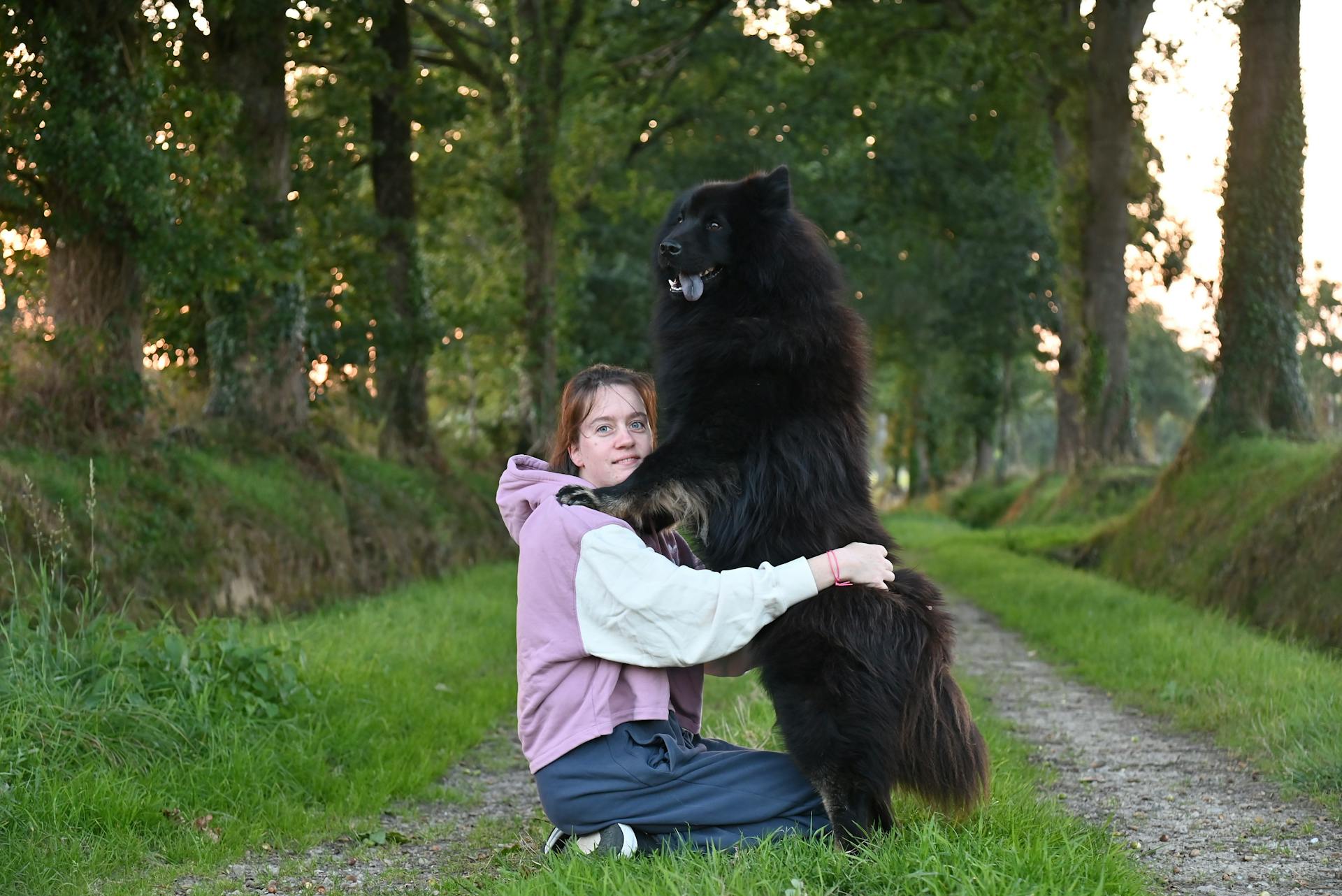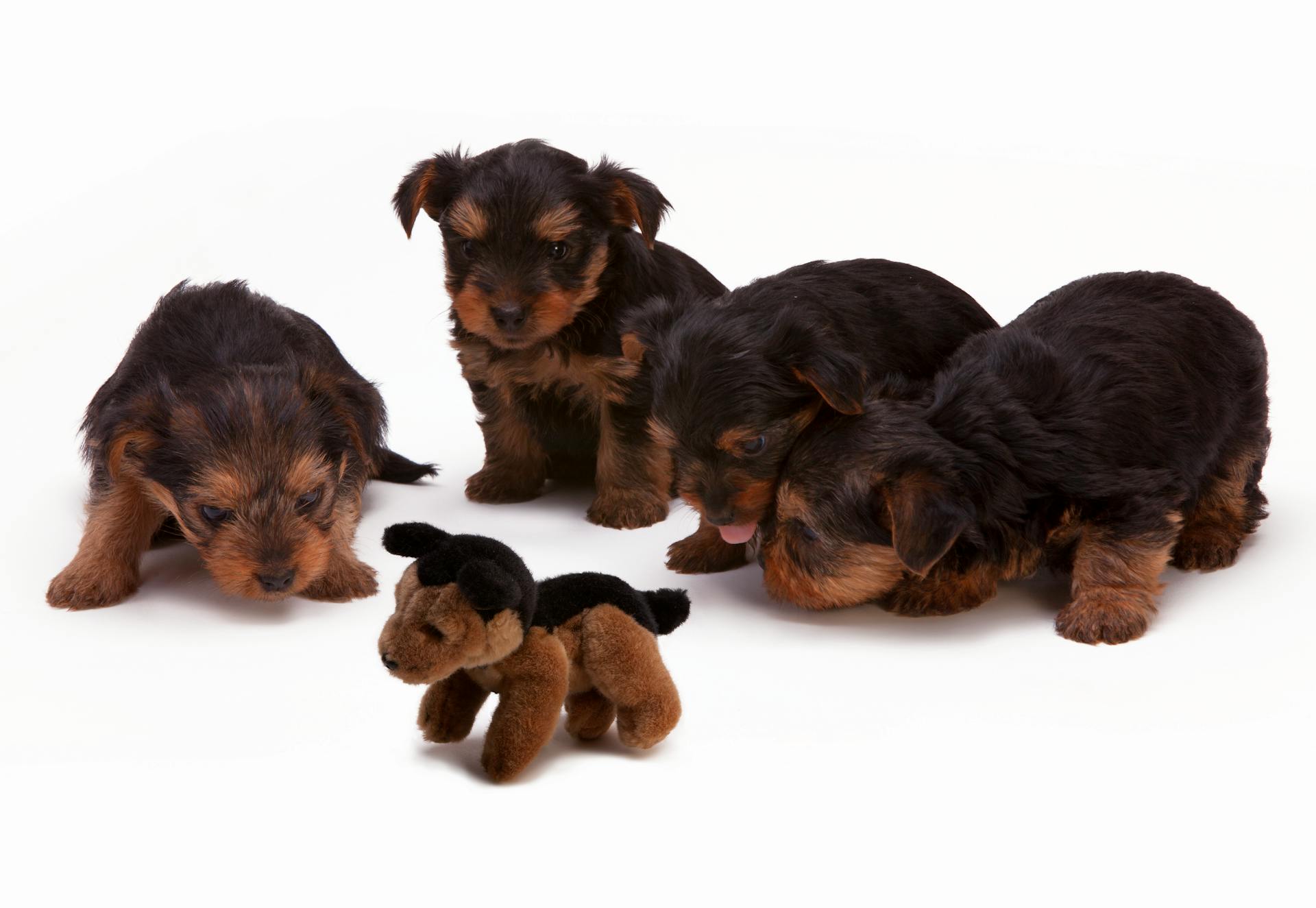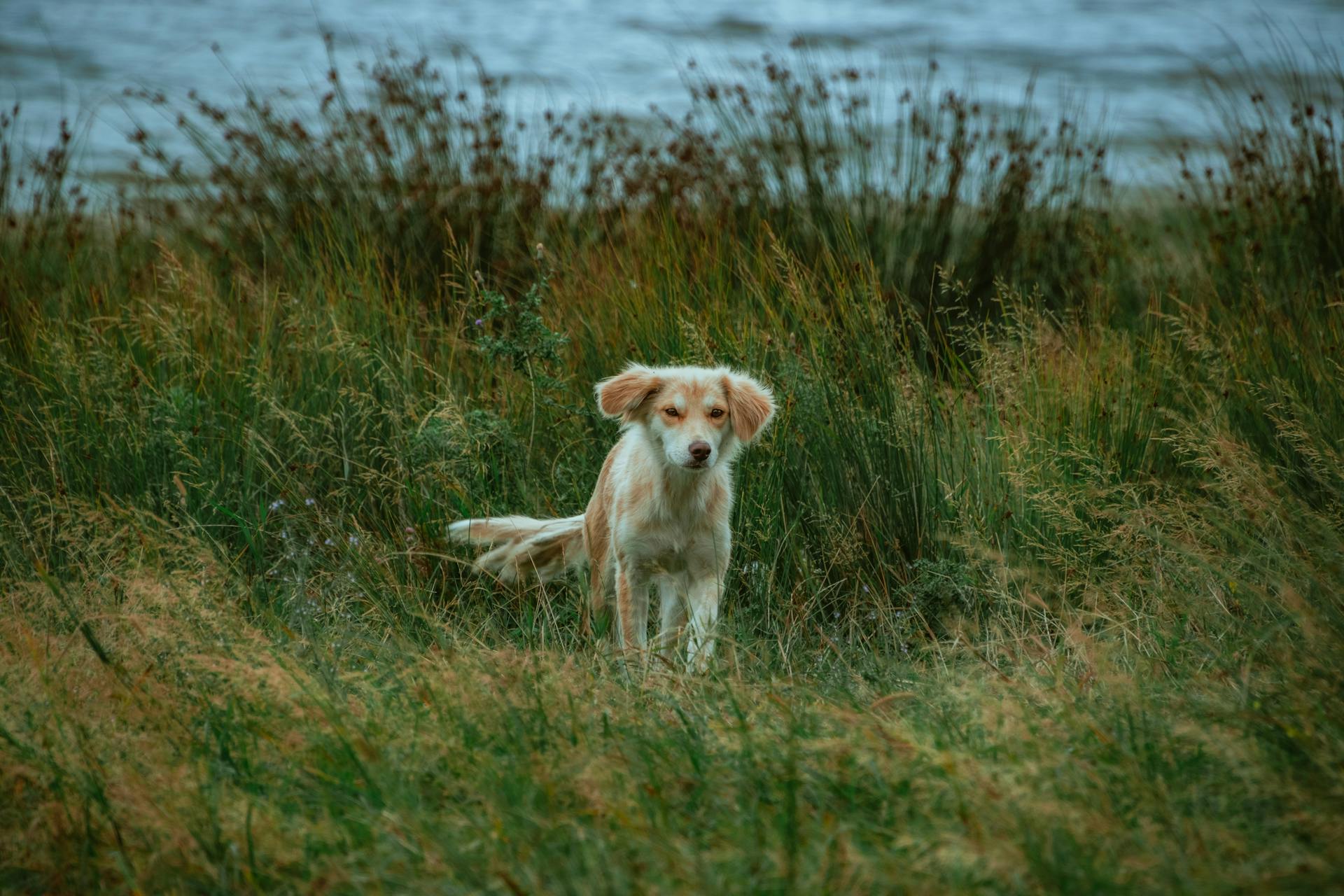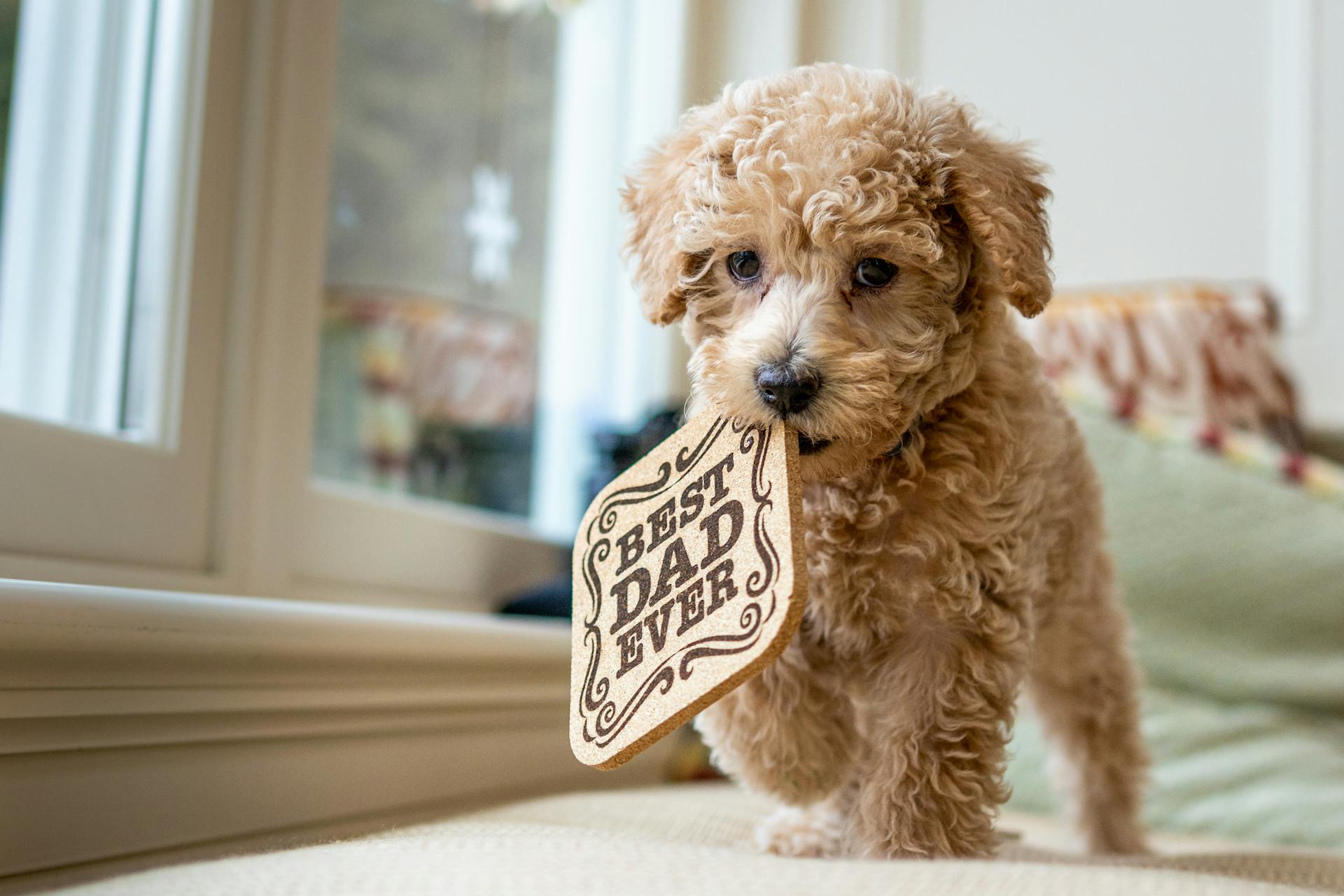
Owning a Tibetan Mastiff is a significant commitment that requires careful consideration. These dogs are massive, with males weighing up to 230 pounds and standing as tall as 26 inches.
To ensure you're prepared for the responsibilities that come with owning a Tibetan Mastiff, it's essential to research reputable breeders. Look for breeders who have experience with the breed and can provide health clearances for their dogs.
Tibetan Mastiffs are known for their loyalty and protective nature, making them excellent guard dogs. However, this also means they can be wary of strangers and may require time to warm up to new people.
Their thick coats require regular grooming to prevent matting and tangling.
Personality and Temperament
The Tibetan Mastiff is an independent breed that expects to be treated as an equal, not as a pet. They have a strong sense of self and can be stubborn at times.
They are intelligent and love to please their people, but they also have their own agenda and must often be reminded of what they've been asked to do. Early socialization is key to preventing territorial aggression.
Tibetan Mastiffs are loyal family guardians who take their job seriously and are aloof or reserved toward strangers. This is a result of their original purpose as livestock guardians, where they were left to patrol and determine what was a threat.
They can be loving with family and quite playful when the mood takes it, but their independence and guarding instincts can make them wary of strangers. You'll need to show your dog who they can trust, and once they see this, they'll learn to befriend visitors.
Tibetan Mastiffs are naturally protective of their family and can become defensive if they perceive a threat. However, this behavior is not a sign of aggression but rather a manifestation of their deep-seated role as protectors.
Their size and strength mean they need a strong, capable handler, and they're not suitable for life in a small apartment. They can bark if left outside for long periods, but they don't tend to be vocal when kept indoors as part of the family.
Health and Care
As a responsible Tibetan Mastiff breeder, it's essential to be aware of the potential health issues that can affect your furry friend. Joint problems like hip dysplasia and elbow dysplasia are common in giant breeds like the Tibetan Mastiff.
Hip dysplasia occurs when the bones of the hip don't align properly, often due to uneven growth. This can lead to painful arthritis and may require surgery or pain medication to manage symptoms.
Elbow dysplasia, on the other hand, is a congenital orthopedic disorder that causes arthritis in the elbow joint. It's most commonly seen in large breeds.
To help prevent or manage elbow dysplasia, it's crucial to prevent obesity, which can put extra strain on your dog's joints. Maintaining musculoskeletal strength through regular exercise and a healthy diet can also make a big difference.
Here are some potential health issues to watch out for in your Tibetan Mastiff:
- Epilepsy
- Hyperthyroidism
- Elbow Dysplasia
- Hip Dysplasia
Coat Color and Grooming
The Tibetan Mastiff has a thick double coat, with a long, thick topcoat and a heavy, soft undercoat. The undercoat is thinner in warmer months.
The topcoat is hard and straight, never curly, wavy, or silky. Males generally have more coat than females, including a thicker mane around the neck and shoulders.
The Tibetan Mastiff coat comes in black, brown, gold, and blue, with or without tan markings. Some dogs have small white markings on the chest and feet, but nowhere else on the body.
The breed sheds little, and shedding may be seasonal or non-existent depending on the climate. Regular brushing is necessary to remove dead or loose hair.
Brush your Tibetan Mastiff one to three times a week with a wire slicker brush to keep his coat in good condition. Be sure to check for tangles or mats in the mane, breeches, and tail.
The breed has little odor, so baths are usually only needed once a month. Other grooming needs include dental hygiene and nail care.
Brush your Tibetan Mastiff's teeth at least two or three times a week to remove tartar buildup. Daily brushing is even better for maintaining good oral health.
Trim your Tibetan Mastiff's nails once or twice a month, or as needed. If you can hear the nails clicking on the floor, they're too long.
Discover more: Tibetan Mastiff Mix Breed
Training and Socialization
Training and Socialization is crucial for Tibetan Mastiffs. They require good obedience training due to their size and natural energy.
A certified dog trainer and behavioral therapist recommends prioritizing obedience training for this breed. They can easily become like a bull in a china shop when they get a burst of energy.
Tibetan Mastiffs are not typically aggressive, but they do need proper training and socialization to manage their natural energy.
Lifestyle and Compatibility
Tibetan Mastiffs require a lot of space to roam, so they're best suited for experienced owners with large homes and yards.
They can get along with other pets, especially if introduced at a young age, but it's essential to introduce them slowly and under controlled circumstances.
Tibetan Mastiffs are loyal and gentle with their family, but they can be aloof with strangers, making socialization crucial for their development.
Their independent nature can make training challenging, but with experience and patience, they can thrive as loving and loyal companions.
They're not ideal for first-time owners or those with limited time, as they need consistent attention and exercise to stay happy and healthy.
Their guarding instinct is a natural part of their breed, so it's essential to acknowledge and respect their protective nature.
Additional reading: Why Tibetan Mastiff Is so Expensive
Children and Pets
If you're considering a Tibetan Mastiff as a pet, it's essential to think about how they'll interact with your children.
Tibetan Mastiffs are generally great with older children, but they can be too large and boisterous for toddlers, so it's crucial to supervise interactions closely.
They may feel the need to protect their "children" from other kids, especially if they're wrestling or fighting, so it's vital to teach your child how to approach and touch dogs gently.
Tibetan Mastiffs get along well with other dogs and cats when they're raised with them, but as adults, they may require more time to adjust to new pets.
Always supervise playtime between dogs and young children to prevent biting or ear or tail pulling.
Teach your child to never approach a dog while it's sleeping, eating, or trying to eat, as this can be perceived as a threat.
Tibetan Mastiffs are naturally protective of their family and territory, so it's essential to socialize them well to prevent unwarranted defensive actions.
Roof Living

Roof Living is a unique lifestyle choice that requires careful consideration of several factors.
For one, it's essential to have a sturdy and well-maintained roof to support the weight of a living space. A roof's lifespan can range from 20 to 50 years, depending on the material used.
The ideal location for a roof living space is often debated, but generally, south-facing slopes receive the most sunlight, making them perfect for solar panels and passive heating.
General Information
The Tibetan Mastiff breed is a huge, hairy dog that can weigh as much as 150 pounds and has a long, thick double coat.
They are known for being affectionate and gentle with their owners, but they have a guarding instinct, which means they won't always take to strangers easily.
Tibetan Mastiffs are thought to be one of the world's oldest dog breeds, with a history dating back to 1100 B.C. in Central Asia, specifically China.
They were originally ferocious guards in the Himalayan mountains, tasked with prowling villages at night to keep unwanted visitors out.
The breed was first recognized by the Tibetan Breed's Association in England in 1931, but it took until 2006 for them to be recognized by the American Kennel Club.
History of My Breed
The Tibetan Mastiff is one of the world's oldest dog breeds, with a history dating back over 5,000 years to ancient Tibet.
DNA evidence suggests that mastiff-type dogs originated in Tibet around 5,000 years ago, and the Tibetan Mastiff is a descendant of those dogs.
Tibetan Mastiffs were once used as ferocious guards in the Himalayan mountains, where they would prowl the villages at night to keep out unwanted visitors.
They were also known as "tied" or "chained" dogs, as they were kept tied up during the day.
In 1847, the viceroy of India gave a Tibetan Mastiff named Siring to Queen Victoria, who owned many pups throughout her lifetime.
The Tibetan Mastiff breed standard was first created in 1931 by the Tibetan Breed's Association in England.
It wasn't until 2006 that the Tibetan Mastiff was recognized by the American Kennel Club and joined the Working Group.
Dog
The Tibetan Mastiff is a huge, hairy dog that can weigh as much as 150 pounds. They have a long, thick double coat.
These dogs are intelligent, but their guarding heritage means they're used to being given a task to do and being left to do it. They can be stubborn, which makes training more challenging.
Tibetan Mastiffs are loving and affectionate with their owners, but they can be aloof and independent. They have a guarding instinct, which means they won't always take to strangers easily.
They require experienced owners who can provide them with structure and clear boundaries. Proper fencing is a must, as they can climb fences.
Tibetan Mastiffs need to be socialized from an early age to meet various people and go to different places. This can help prevent them from becoming too territorial.
Their daily food intake should be around 4 to 6 or more cups of a high-quality dog food, divided into two meals. You should also monitor their weight to ensure they're not overweight.
To determine if your Tibetan Mastiff is at a healthy weight, look for a visible waist and feel their ribs without having to press hard. If you can't feel their ribs, they need less food and more exercise.
None

A Tibetan Mastiff needs a large, securely fenced yard to exercise, but a small yard or dog run isn't enough for his needs.
Exercise requirements can be satisfied with 20 to 30 minutes of play in the yard or a half-hour walk. He'll enjoy having another dog to play with, preferably one who comes close to his size.
Tibetan Mastiffs grow more quickly than smaller breeds, but they aren't physically mature until they're more than a year old. This means you should limit exercise to free play in the yard and avoid long walks until your puppy is a year old.
Housetraining comes easily to the Tibetan Mastiff, thanks to their intelligence and ability to learn quickly. Crate training assists in this process and prevents your puppy from getting into trouble.
A bored or lonely Tibetan Mastiff can be destructive and noisy, so regular training practice and social interaction are crucial. Socialization is a must for this breed, as they can be overly dominant toward other dogs and protective of their home and family.
Tibetan Mastiffs can weigh up to 160 pounds or more, so good leash manners are essential, especially since they'll eventually be able to pull you where they want to go.
Consider reading: Old English Sheepdog Puppy Breeders
Frequently Asked Questions
How much does a Tibetan Mastiff puppy cost?
A Tibetan Mastiff puppy typically costs between $2,000 and $6,000, which may include additional services such as house training, vaccinations, and spaying/neutering.
Are there Tibetan Mastiff breeders in the United States?
Yes, there are Tibetan Mastiff breeders in the United States, including one family in southeast Michigan that breeds and trains the breed. They welcome visitors interested in learning more about the breed.
Are Tibetan Mastiffs legal in the US?
In the US, there are no federal laws banning Tibetan Mastiffs, but local regulations may vary. However, their size and protective instincts can be a concern, making training essential.
Can Tibetan Mastiff be a house dog?
Yes, Tibetan Mastiffs can make great house dogs, as they are generally quiet and laid back indoors. With proper training, they can thrive in a home environment and follow household rules.
Featured Images: pexels.com


